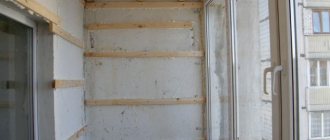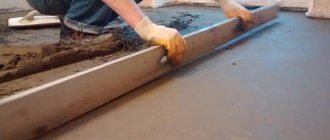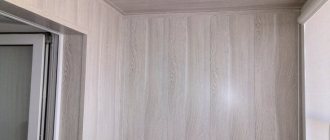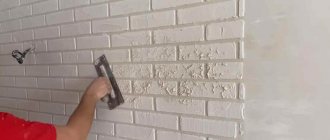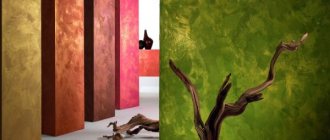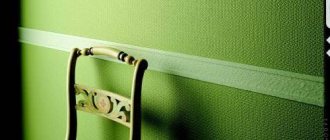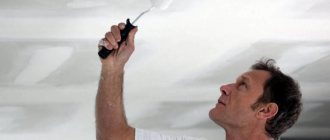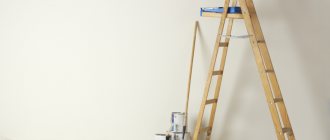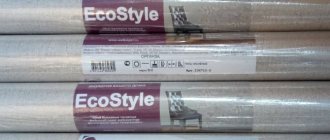Ceiling glass wallpaper is an environmentally friendly finishing material, a serious competitor to non-woven and fabric coverings, as well as the now popular stretch ceilings. They are made from quartz sand and various additives - clay, limestone, dolomite. The mixture is melted and threads are drawn out, from which textiles are woven, outwardly indistinguishable from ordinary ones. The material has many advantages for which it is often used in interior design. This article will discuss the pros and cons of such repairs, as well as installation methods and the nuances of do-it-yourself painting.
Pros and cons of glass wallpaper for ceiling finishing
This type of coating has gained popularity due to its advantages:
- fire safety class KM1 - they do not support combustion, do not spread fire and smoke, and do not emit toxic substances;
- environmentally friendly;
- durable, have reinforcing properties, tighten cracks;
- serve for at least 30 years;
- protect the room from external noise;
- are breathable;
- easy to clean;
- the textured surface hides some rough finishing errors;
- dielectric, so dust does not collect on the ceiling;
- hypoallergenic and suitable even for a children's room;
- do not cause the formation of fungus or mold;
- resistant to moisture, temperature changes, and do not fade when exposed to sunlight.
Glass wallpaper for the ceiling will decorate the interior of any room. They are even suitable for the bathroom, kitchen and glazed balcony, if you properly prepare the surface and use waterproof paints.
However, the coating is not without its drawbacks. Of the minuses, the masters note:
- high price of both the wallpaper itself and related materials;
- peeling from the surface due to non-compliance with gluing technology;
- difficult dismantling, since glue and impregnations provide strong adhesion;
- irritation of the skin and mucous membranes - when working with the material, you must use personal protective equipment.
Photo ideas in the interior
For the bathroom
Fiberglass wallpaper will be a good finishing option for a bathroom. They are not afraid of moisture and will not allow fungus and mold to appear.
The photo shows a bright bathroom. The decoration is made with glass fabric wallpaper in turquoise color.
For greater strength and reliability, the fiberglass fabric is coated with washable paint.
The photo shows a spacious bathroom decorated with fiberglass wallpaper in blue.
For kitchen
A big advantage can be considered the high fire resistance of glass wallpaper.
The photo shows a modern kitchen decorated with glass wallpaper in neutral colors.
In the kitchen, this fact is very relevant. At high temperatures, fiberglass sheets do not emit harmful substances. In addition, replacing glass wallpaper will cost less and the work will be easier. Suitable for finishing the dining area.
In the toilet
In the toilet, as well as in the bathroom, it is important to minimize the possibility of mold and mildew. Fiberglass wallpaper will help with this; they will be a good alternative to tiles. In addition, their cost is lower than tiles.
In the hall
The strength of the fiberglass material will eliminate mechanical damage to the surface, and the waterproof coating is easy to care for and keep clean.
On the balcony
Fiberglass wallpaper is not afraid of changes in temperature and humidity; it will be a practical solution for finishing a glazed balcony or loggia.
Types of glass wallpaper
Rolls are produced 1 m wide and 25–50 m long. However, the sizes may be different, especially if the coating is produced to order - some companies provide this service.
The material is selected according to several criteria:
- Texture : smooth, embossed. The former are also known as glass interlining, and are more often used as a reinforcing coating. The latter have a clearly defined texture; a convex ornament or pattern can be seen on them, which depends on the loom - rhombus, herringbone, bamboo, matting, jacquard and others. This material is thicker and heavier than textureless material. The relief can be very deep and on the ceiling imitates decorative plaster with stucco elements.
- Class - 1, 2, economy. The most durable wallpaper of class 1, with a density of 100 g/m2 and higher. Such coatings last 30 years or more. Class 2 material is less durable, and the pattern and texture on it lose their expression when repainted. Economy category canvases are the thinnest and often defective.
- Compound . The coating consists of fiberglass and impregnation; the optimal ratio is 70%/30%, respectively.
- Density _ The thinner the wallpaper, the lighter, cheaper and easier it is to glue. But thick material lasts longer and can be repainted more times.
- Color . There are two types of glass fiber - colored and paintable. In the first case, a topcoat is not required since the pigment is added to the fibers. But if desired, it can also be painted. Coatings for painting are usually white or milky in color.
- Special properties : anti-vandal, anti-claw. Such materials are resistant to mechanical stress and scratches.
If you don’t like the range of finished products, you can order a coating according to your design. Such services are provided by some manufacturers.
When choosing wallpaper, it is important to pay attention to the quality of the canvas. The weaving should be neat and the edges should be even. Another critical parameter is water resistance. Manufacturers provide this information on the label with wave-shaped icons:
- one - withstands only a damp cloth and suede;
- two - medium level, soap may be used;
- three - the use of non-abrasive cleaning products is allowed.
Fiberglass may have other properties. Thus, you can purchase products coated on the back with glue, which is activated by water. When using them, the work is significantly reduced, and bubbles occur less frequently. Some factories, in order to reduce repair time, produce materials with a primer layer.
To get a high-quality coating, you should buy wallpaper from well-known and trusted manufacturers. A lot of low-quality products are produced, which often lack the advantages that high-quality fiberglass fabrics have. The following brands are considered the best on the Russian market:
- Practical;
- Pufas;
- Wellton;
- X-Glass;
- Colors;
- Kleo.
The cost of one roll is from 1300 rubles. Often well-known manufacturers provide a guarantee for their products. Therefore, when purchasing material, you should ask the seller about this option. If it is available, then you need to ask for a warranty card in the store and keep the receipt.
Special glue
For wallpaper installation, mixtures developed for this material are used. They have increased adhesion and take into account the characteristics of the fiberglass coating. Among the most famous brands:
- Oscar;
- Quelyd;
- Axton.
Many products are available in both ready-to-use and dry forms. The first ones are sold in sealed packaging. After opening the cans, they must be used as quickly as possible, since after this their shelf life is sharply reduced.
In general, craftsmen recommend buying glue from the same manufacturer that produces glass wallpaper. It should be quite viscous; it is advisable that the composition includes PVA glue. You should not use other heavy wallpaper products as a replacement - they are not able to provide adhesion.
What are glass wallpapers made from?
The raw material for the production of glass wallpaper - fiberglass yarn - is obtained from glass melted at a temperature of 1200 0C from rocks such as limestone, quartz sand and dolomite. The molten glass is then drawn into thin translucent fibers.
In addition to fiberglass wallpaper, fiberglass is used to make fiberglass (or web), which is widely used as a reinforcing material. Fiberglass makes the surface smooth and velvety. To obtain fiberglass, fibers are pressed using the wet paper method.
Fiberglass wallpaper, unlike canvas, is spun on special equipment reminiscent of a traditional loom. Fiberglass yarn is used to produce threads from which the wallpaper itself is subsequently created. To stabilize the material, the woven fiberglass fabric is impregnated with a special starch-based composition.
[custom_ads_shortcode2]
Preparing the ceiling surface
Fiberglass wallpapers have considerable weight. Therefore, the working surface must be finished accordingly before installation:
- Remove old coverings. Pre-soak liquid lining wallpaper. If the ceiling was previously covered with fiberglass, it also needs to be cleaned or sanded.
- Level the base with putty.
- Seal small cracks, joints between sheets of drywall, and places where screws are attached with serpyanka.
- Remove irregularities protruding more than 2-3 mm - sand with a mesh and a sanding sponge.
- Holes are made for recessed lamps in the suspended ceiling.
- Prime with acrylic based deep penetrating agents.
Chipboard, wood or solid fibreboards are first coated with a layer of insulation. The surface is sanded and puttied, and steps 3-5 are repeated.
You can then test the strength of the plaster using self-adhesive tape. The tape is glued to the ceiling and peeled off - it should remain clean.
Novice craftsmen sometimes ignore the stage of puttingtying plasterboard. But this is a mistake. In the future, if you have to dismantle the wallpaper, the construction cardboard that covers the outside of the plasterboard panels will also be damaged.
Gluing technology
Any glass wallpaper should be glued to the ceiling at room temperature 18...25 °C. Drafts should be eliminated and the ceiling should not be exposed to sunlight until the coating is completely dry.
When bent, the finest glass fibers can break, and when they get on the skin or respiratory organs, cause irritation - just like glass wool. Therefore, it is necessary to use personal protective equipment - gloves, long sleeves, respirators, a knitted cap or bandana.
It is also necessary to dilute the glue, if it is in powder form, in accordance with the manufacturer's instructions. Usually the mixture “ripens” for about 15 minutes, after which it can be used.
To work you will need:
- tray for glue;
- brush;
- roller;
- pressing plastic spatula for wallpaper.
It is better not to use a metal tool, as this can damage the structure of the canvas.
It is also necessary to mark the work surface. Wallpaper on the ceiling should be glued from the center or from the wall. The first method is used if the canvases have a large, pronounced pattern. Then the ornament will be located symmetrically relative to the middle of the room. To do this, draw diagonals; at the intersection of the lines there will be a center. It should coincide with the middle of the fiberglass strip. Materials with small patterns are glued away from the window. A line is marked along the wall at a distance equal to the width of the roll.
Next they do the cutting. Fiberglass wallpaper has a face and a back. The part looking into the room - with a pronounced texture - faces the inside of the roll. A sticker is applied to the back informing that this side should be glued.
The canvas is cut along the length of the base wall plus another 10 cm allowance on the sides. A large drawing needs to be joined. There will be less waste if you cut two rolls at once.
Pasting the ceiling with glass wallpaper is carried out in the following sequence:
- Apply glue, slightly protruding beyond the edges of the mark; do not coat the material.
- The sheet is applied to the ceiling and smoothed with a plastic wallpaper spatula from the center to the edges, expelling the air.
- Excess glue is removed with a slightly damp sponge, which is lightly pressed against the work surface. It is better not to use napkins and rags.
- Coupling occurs in 5–10 minutes. During this time, you can adjust the position of the wallpaper on the ceiling.
- Cuts are made where there is space for recessed lamps.
- Apply the next area.
- Glue the second sheet butt to the first.
- The junction of the canvases is pressed at the very end, and a spatula is drawn along the resulting seam.
Wallpaper with a small “matting” pattern and similar ones can be joined using the “double cut” method. Then one piece of canvas is superimposed on another. A slot is made in the middle of the overlap with a knife. Thin strips are removed from both canvases, and the resulting joint is smoothed with a spatula or pressure roller.
No need to worry if the edges don't stick the first time. Then you should carefully pull the material away from the wall, coat the dry areas with glue, press the fiberglass and go over it again with a plastic spatula.
If the manufacturer has applied dry glue to the back of the wallpaper, then there is no need to coat the wall. Then you will need a container with clean water at a temperature of 10...25 °C. Each strip of wallpaper is soaked on the back and front for 3 seconds to 5 minutes to activate the composition, but not longer, since the adhesive properties will weaken. Then the material is applied to the ceiling and leveled with a spatula, as described above.
Fiberglass wallpaper takes 24–48 hours to dry. During this period, it is necessary to keep windows and doors closed to prevent drafts. Then the excess along the edges is trimmed with a mounting knife.
After finishing the sticker process, you need to take a shower to wash off the fiberglass shards from your skin.
Painting nuances
Most glass wallpapers indicate that they can be coated with a finishing agent within 2 hours after installation. But to be safe, it is better to wait at least a day for the glue to completely set.
As a finishing coating, water-dispersed paints and varnishes are used - water-based, acrylic, latex. In rooms with high humidity, two-component products are recommended - polyurethane, based on epoxy resins.
For painting you will need:
- long pile roller or sprayer;
- brush 80–120 mm wide;
- rolling;
- drill with whisk for stirring.
The walls around the perimeter of the ceiling are covered with masking tape so as not to stain the coating. The roller is first rinsed well under water and rolled over any rough surface to get rid of any emerging lint.
The ceiling is first coated with a primer mixture. This will significantly increase adhesion to fiberglass and improve the dyeing result: it will increase the brightness of the pigment and reduce paint consumption. As a starting impregnation, you can use a more liquid glue or a universal primer. Then you need to wait until the impregnation dries. If the wallpaper is primed at the factory, there is no need to additionally treat it with any compounds.
The ceiling under the glass wallpaper is painted in the following sequence:
- Treat the corners with a brush.
- The main area is painted with a roller.
- Inspect the surface, and if you find smudges or drops of paint, get rid of them immediately.
- After 8–12 hours, apply a second layer of paintwork.
You need to paint the entire ceiling at once. If you take a long break in work while applying one layer, transitions and spots may form. For textured surfaces, apply paint for the first time, diluted as much as possible with water according to the manufacturer's instructions.
Unusual coloring methods
Plain textured wallpaper looks beautiful. But sometimes this design seems boring. Those who like more original solutions can use one of these techniques:
- You will need two contrasting colors. First, the first tone is applied to the wallpaper in 1-2 layers, and after complete drying, the second tone is applied. Without waiting for it to dry, remove excess paint with a metal spatula: the tool is held at an angle and moved effortlessly so as not to damage the fiberglass. The canvas turns out to be two-color, the texture is more expressive.
- The principle of coloring is the same as described above. But in this case, instead of a second paint, a gliding coating is used - for example, varnish with gold glitter.
- Glass wallpaper of two textures is selected for the ceiling and pasted according to a pre-selected pattern - for example, one canvas serves as a frame, the other as a background. For them, different paint colors are used. The joints between them are hidden behind moldings.
- Using stencils, designs are applied to an already painted surface. They can be contrasting or differ by half a tone from the background. This technique is most suitable for smooth and finely textured wallpaper. To work with stencils, a roller or sponge is usually used.
A little more about the advantages
As mentioned above, glass wallpaper can be repainted. Whether or not to paint fiberglass wallpaper is a matter of taste. For this, it is recommended to use latex-based water-dispersion paint. Glass wallpaper can be painted only after it has completely dried, i.e. no earlier than 2-3 days after gluing. Otherwise, the wallpaper may simply fall off under the weight of its own weight and paint. With each subsequent repair, you do not need to glue new glass wallpaper to the ceiling; you can simply repaint the existing ones in a different color. You can repaint glass wallpaper up to 10 times. However, it is worth remembering that painted glass wallpaper cannot be used as a reinforcing material in the future, because It is very difficult to putty on a surface covered with paint. But on the other hand, the glass wallpaper coating itself, paired with paint, forms a fairly reliable reinforcing effect on the surface.
Features of surface care
Fiberglass wallpaper itself is durable. How to care for them usually determines the type of finish. In general, keeping the ceiling clean with this finish is easy:
- stains are removed with non-abrasive detergents;
- if the characteristics of the paint allow, you can even use a brush;
- in rooms with normal humidity, dust is removed with a vacuum cleaner or dry textiles.
For difficult to remove stains or fading, repainting will help. Fiberglass wallpaper can withstand 12 to 30 color change cycles. But you can’t overdo it: although the coating adheres quite firmly to the base, it may not withstand the weight of the finish and fall away from the wall.
Fiberglass is an interesting and convenient material. It lasts for decades without any special care. Therefore, the high cost of such finishing is always justified.
Material characteristics
To understand whether it is possible to glue glass wallpaper to the ceiling and how to do it, you should first understand the characteristics of this type of coating. The fiberglass fabric that serves as the basis in this case is made from glass threads woven and pressed into one large sheet. Once manufactured, large pieces of fiberglass fabric are cut into pieces that are formed into rolls ranging from 25 to 50 meters in length. The width of the canvas is one meter.
Two types of such wallpaper are produced: “cobweb”, so named because of the characteristic pattern on the surface, and “matting”, similar in texture to the fabric of the same name. The first type is used to give the plane higher strength and this type of ceiling finishing with fiberglass wallpaper is used most often in combination with a plasterboard surface. This makes an excellent base for applying putty.
If you stick such glass wallpaper onto a regular ceiling, the surface acquires additional strength. This type of design is recommended to be used when the base surface is not too strong - the outer layer may crumble or needs strengthening. This technique is especially relevant in old houses.
The matting can be used as an almost finished finishing coating. The relief pattern will give the floor plane an excellent appearance, and the fiberglass will create a durable surface. At the same time, the resulting surface can be easily painted in any desired color. In addition, it is possible to cover the ceilings with glass wallpaper already painted at the factory.
